For backyard bird lovers, hawks can be a big worry. These birds of prey can disrupt the balance in your backyard. But, there are ways to keep hawks away without hurting the songbirds you want to protect.
Linda loved watching the sparrows, finches, and chickadees at her feeders. But, hawks like the sharp-shinned and Cooper’s hawks made her sad. She wanted to keep them away without hurting her backyard’s balance.
Key Takeaways
- Understand the common hawk species that target backyard feeders, such as Sharp-shinned Hawks, Cooper’s Hawks, and Red-tailed Hawks.
- Provide shelter for small birds within 10 feet of feeders to help them escape aerial predators.
- Explore various deterrents, including reflective tape, predator eye balloons, and noise-making devices, to scare away hawks without harming birds.
- Utilize guardian animals like dogs, roosters, or larger livestock to help protect your feathered friends.
- Maintain a vigilant free-range supervision strategy to keep chickens and other poultry safe from hawk attacks.
Identifying the Problem: Hawks Preying on Backyard Birds
Backyard bird lovers often face a challenge: hawks near their feeders. These birds of prey see the smaller birds around feeders as potential food. Knowing which hawks are in your area and how they hunt helps in keeping them away.
Common Hawk Species Found Near Feeders
Several hawk species visit backyard bird feeders. These include the Sharp-shinned Hawk, Cooper’s Hawk, Red-tailed Hawk, Merlin, and American Kestrel. These raptors are great at catching songbirds, which can be a threat to the birds you want to attract.
Understanding the Natural Ecosystem
Hawks are important in the natural world, and their presence isn’t always bad. They keep the ecosystem balanced by controlling smaller bird and animal populations. We should protect our backyard birds but also value hawks and other predators in nature.
“Hawks are a natural part of the ecosystem, and their presence is a sign of a healthy and diverse bird community. By understanding their behaviors, we can find ways to coexist with these impressive predators while still protecting our beloved backyard birds.”
Learning about the hawks in your area and their role in nature helps you keep them away from your backyard. This way, you can protect your birds and respect nature’s balance.
Provide Shelter for Small Birds
Protecting small birds from hawks is key. Use dense trees, shrubs, and brush piles for shelter. These spots let birds hide fast from predators. Also, choose native plants with seeds or fruits to feed the birds and give them safe places near feeders.
Birds need food, water, and shelter to live. A well-designed yard meets these needs and lowers hawk attacks. Planting native shrubs, bushes, and trees helps. It gives birds places to nest and live, and brings more bird species to your yard.
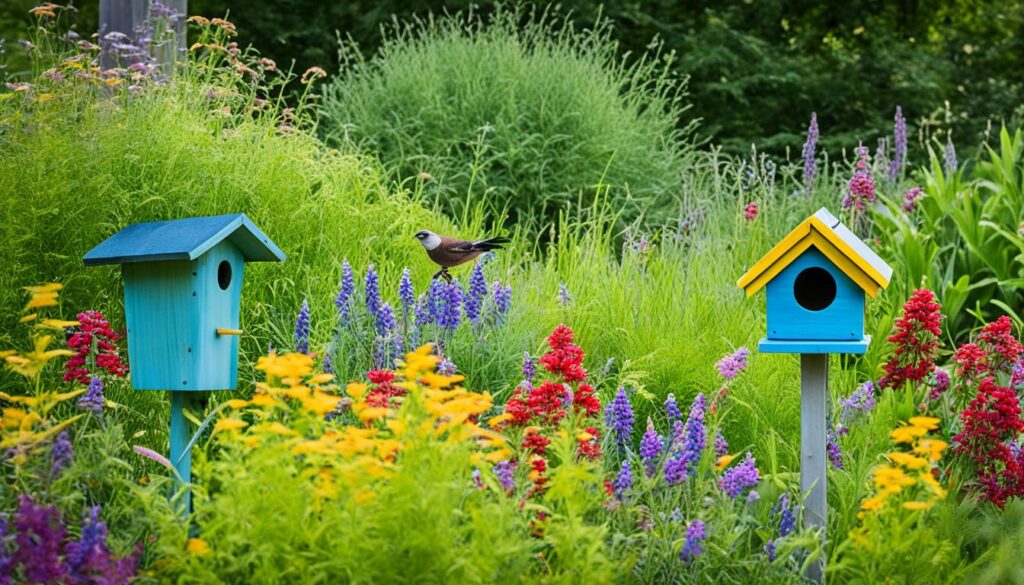
Studies show hawks catch birds only about 10% of the time. With enough natural cover, you can make it harder for hawks to get to small birds.
- Use dense, multi-layered plants for perches and hiding spots.
- Keep fallen leaves and brush piles for more cover and food.
- Put up nest and roost boxes for safe places to nest and rest.
- Don’t remove dead trees and limbs; they’re good for food and shelter.
Creating a bird-friendly yard with lots of cover and shelter helps protect birds from hawks. It also makes your yard a better place for birds to live and thrive.
Shield Feeders from Aerial Predators
Putting bird feeders under an awning or hanging low in trees can protect them from hawks. Hawks have a hard time seeing their prey when it’s hidden under a canopy or awning.
Covered Platform Feeders
Covered platform feeders have a special design that hides birds from hawks. They make it harder for hawks to spot and catch the birds at the feeder.
“Majority of hawk predators are larger birds of prey like owls and eagles. They also prey on similar animals that hawks target.”
Fake owl decoys that move around are great at keeping hawks away. But, you need to move them every few days for them to keep working.
- Ultrasonic bird repellent devices can scare hawks away with certain sounds.
- Roosting spikes can stop hawks from landing near their prey.
- Hawks like to perch in tall trees and on utility poles. Removing these spots can keep them away.
Avoid Ground Feeding to Minimize Risk
Protecting your backyard birds from hawk attacks is key. Birds that feed on the ground are more vulnerable to hawk attacks because they have limited options for quick escape. Hawks like the Cooper’s Hawk and Sharp-Shinned Hawk often target these birds, making them more likely to become prey.
To lower the risk of a hawk attack, don’t use low feeders or feed birds on the ground. Instead, encourage small birds to feed at elevated platforms or in the safety of dense vegetation. This helps keep your birds safe from hawks.
Birds at feeders change their behavior when hawks are around. Some birds leave, letting others take over the feeders. By knowing this, you can make your feeders safer for your backyard birds.
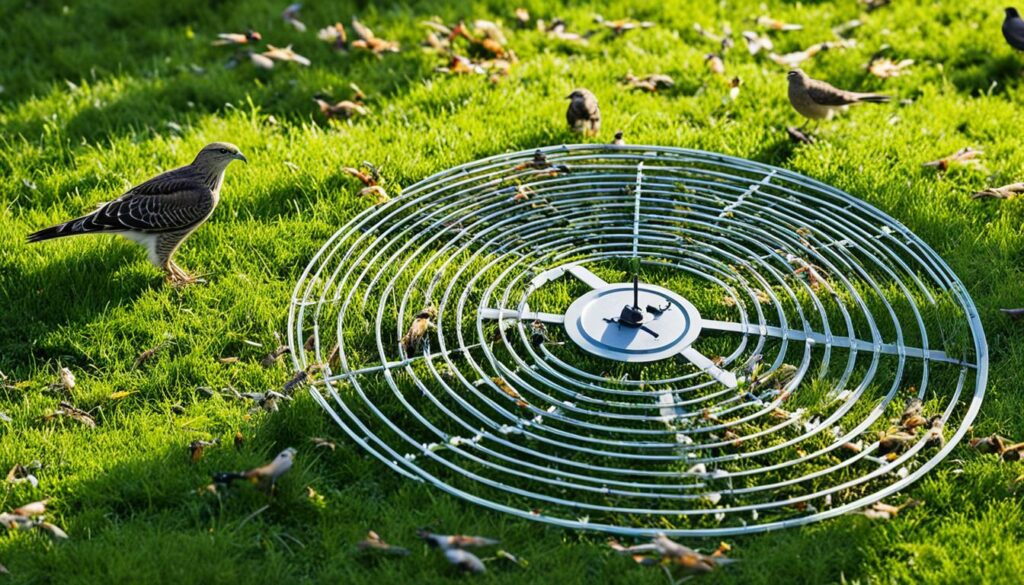
Project FeederWatch data shows that Cooper’s Hawks at feeders went from 6.4% in 1989 to 21.9% by 2014. This shows how more ground-feeding birds are at risk.
How to Scare Away Hawks but Not Birds?
Keeping your backyard birds safe from hawks is tricky. You don’t want to scare away the birds you’re trying to protect. Luckily, there are ways to keep hawks away without harming the birds.
Using Reflective Deterrents
Reflective materials like shiny tape or balloons work well against hawks. They flash and shimmer, confusing and startling the hawks. Hang reflective tape around the coop or trees so it catches the sunlight.
Predator Eye Balloons and Scarecrows
Predator eye balloons and scarecrows look like big predators, like owls. They have scary eyes or look like humans. This keeps hawks away. Move these deterrents often to keep them working and not getting used to them.
Using these methods, you can make your backyard less inviting to hawks. It will still be safe for your birds.
Utilize Noise-Making Devices
Noise-making devices can be a great way to keep hawks away from your backyard. Tools like air horns, wind chimes, or motion-activated sound devices can surprise and scare hawks. These loud noises mess up their hunting plans and make them look for quieter spots to hunt.
A study found that 73% of people saw fewer bird problems after using hawk noise makers. Another study in the Journal of Wildlife Management showed that noise makers cut hawk-related bird crashes by 45% at airports.
But, think about local noise laws and your neighbors before using these devices. They work well to scare hawks but can also bother people nearby. Finding a good balance between keeping hawks away and being considerate is important for peace in the community.
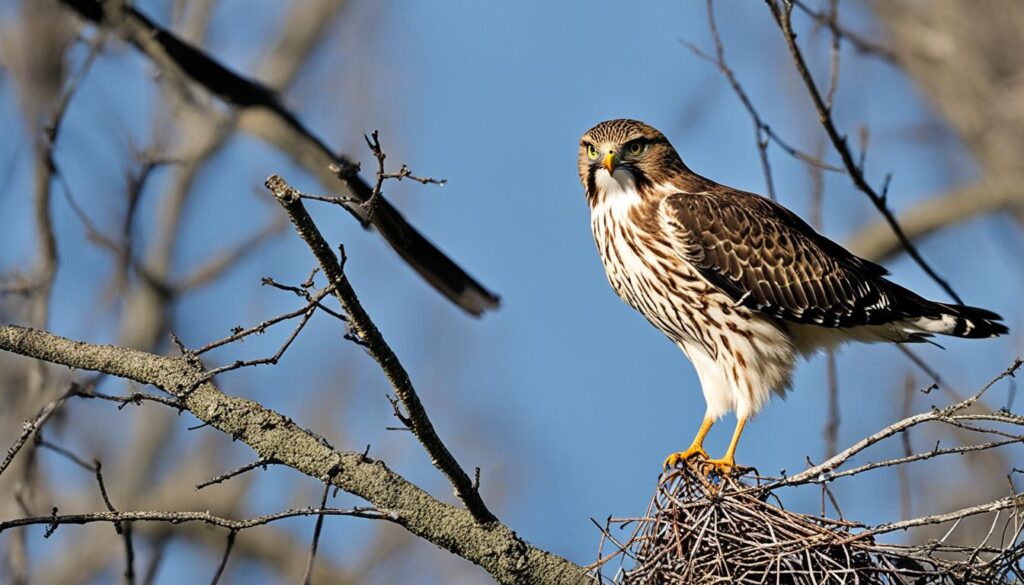
- Air horns can produce sudden, startling sounds that interrupt a hawk’s hunting routine.
- Wind chimes create an unpredictable and unsettling environment for hawks, deterring them from the area.
- Motion-activated sound devices can be strategically placed near feeders to scare off hawks when they approach.
Remember, using noise-making devices to deter hawks should be done responsibly and within local laws. By balancing the needs of your birds and your community, you can keep hawks away without bothering anyone else.
Guardian Animals for Poultry Protection
Guardian animals are great for keeping your backyard flock safe from hawks and other predators. They act as a strong defense and make your chicken coop feel secure. These animals keep a watchful eye over your birds.
Dogs and Roosters as Protectors
Dogs and roosters can keep hawks and other predators away from your chicken coop. Just having them around can make hawks think twice before attacking. Dogs and roosters can also chase away hawks, keeping your birds safe.
Larger Guardian Animals
Donkeys or alpacas can also protect your poultry from hawks. They are very protective and can stop even the most aggressive predators. This includes coyotes, foxes, and hawks.
“Employing guard animals such as dogs, donkeys, or alpacas that mingle with the flock can help protect chickens from hawks.”
Adding these guardian animals to your flock can make a big difference. They help defend against aerial threats and keep your birds safe.
Practice Free-Range Supervision
Watching your free-ranging chickens or small birds closely is key to stopping hawk attacks. Make sure they have a safe area where you can see them. This lets you act fast if a hawk appears. Knowing when hawks are most active helps you watch them closely during those times.
Supervising your flock when they are free-ranging is crucial. Experts say one person can’t watch more than 10 chickens at once. If you have a big flock, you might need help to keep your birds safe.
The best time for your birds to be outside is just before dusk, when hawks are most active. Never stray far from your free-ranging birds, so you can quickly respond to threats. Also, check your birds often for injuries like bumblefoot to keep them healthy.
“Many initially against free-ranging have tried supervised techniques and became advocates.”
Some people who were unsure about free-ranging at first have now become supporters. They changed their minds after trying a supervised approach. This shows the good things about free-ranging with the right safety steps.
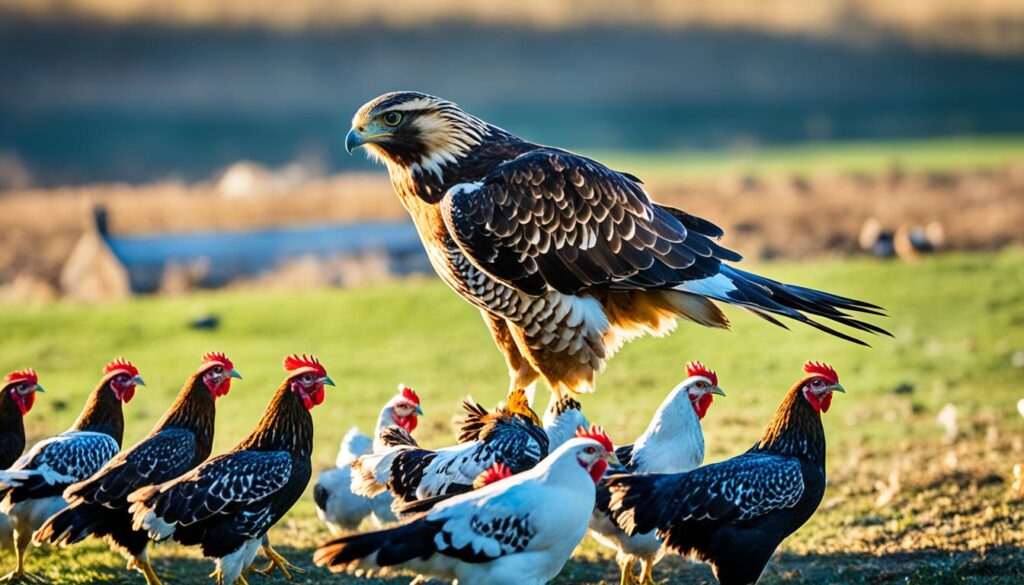
- Potential Daytime Predators of Free-Ranging Flocks: Hawks/Birds of Prey
- Benefits of Free Ranging: Decrease in the amount of feed your flock consumes
- How To Supervise Free-Ranging: One person cannot supervise more than 10 chickens at one time
- Best hours for supervised free-ranging: Just prior to dusk
- Number of recommended individuals needed for supervising based on the flock size: Depending on the flock size, more than one person may be required
- Important advice on supervising free-ranging flocks: Never stray far from your free-ranging flock
- Regular checks recommended for free-ranging chickens: Check the foot pads regularly for injuries such as bumblefoot
- Conversion rate of skeptics to advocates of supervised free-ranging: Many initially against free-ranging have tried supervised techniques and became advocates
Remove Attractants from Your Property
To keep hawks away, remove things that might draw them in. This means securing food and water that could attract them. By doing this, you make your yard less inviting for hawks, keeping them away from your birds.
Securing Food and Water Sources
First, keep chicken feed, bird seed, or pet food in airtight containers. Hawks are attracted to easy food, so make sure it’s not out in the open. Also, cover any water sources like birdbaths or pet bowls to stop hawks from using them.
Always clean up any food scraps or spills outside. A clean yard means fewer attractants for hawks. These simple actions can help keep hawks away from your birds.
“Reducing the availability of easy prey and resources can make your backyard less appealing to hawks, making them less likely to target your feathered friends.”
Grow Plants for Natural Cover
Planting shrubs, bushes, and trees around your chicken coop or bird feeders helps create barriers. These barriers give small birds a safe place to hide. They also make it harder for hawks to see and attack them.
When picking plants, look for ones with thick leaves that can protect and hide your birds. Blueberry or mulberry bushes are great because they offer food and shelter. Trees like maples or oaks grow fast and can create a canopy to protect your birds from above.
- Strategically plant shrubs, bushes, and trees around the chicken coop or bird feeders.
- Choose plants with dense foliage to offer protection and concealment for small birds.
- Incorporate a mix of low-growing bushes and tall, fast-growing trees to create a multi-layered defense system.
This method keeps hawks away and makes your backyard look better. It becomes a place that welcomes wildlife. Using plants is a smart way to keep hawks off while keeping your birds safe.
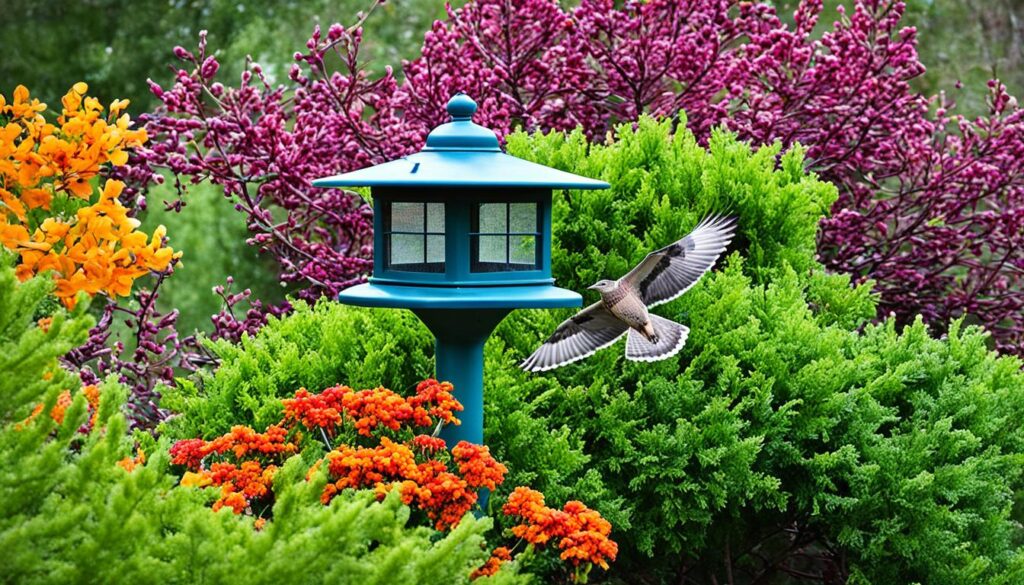
“A well-designed landscape with strategic plantings can be a highly effective and eco-friendly way to protect your backyard birds from aerial predators.”
Invest in Hawk-Proof Feeders and Waterers
To keep hawks away from your backyard birds, consider hawk-proof feeders and waterers. These items have special barriers and features that stop hawks from getting to the birds. They give your birds a safe place to eat and drink without hawk threats.
Hawk-proof feeders and waterers have important features like:
- Sturdy wire cages or enclosures that restrict hawk access while allowing smaller birds to feed
- Domed or covered designs that block aerial predators from swooping down
- Perches positioned at a height that discourages hawks from landing and hunting
- Innovative weight-sensitive mechanisms that close off access when heavier birds or predators approach
These containers make a safe spot for your backyard birds. They can eat and drink without fear of hawks. By using these solutions, you protect your birds and keep your outdoor space peaceful.
Protecting your backyard birds takes more than just hawk-proof feeders and waterers. Use these with other deterrents for a full plan to keep your small birds safe and happy.
Advanced Strategies for Hawk Deterrence
To keep backyard birds safe from hawks, you need a mix of strategies. Using advanced methods can make your chicken coop less visible to predators. This helps protect your birds.
Camouflaging the Coop
Using earthy colors or natural plants can hide your chicken coop from hawks. Adding netting or fencing that reaches the ground and plants helps it blend in. This reduces the chance of hawk attacks.
Automated Sprinkler Systems
Motion-activated sprinklers can scare away hawks and other threats near the coop or feeders. They spray water when they sense movement. This is a smart and kind way to keep your birds safe.
By using these strategies together, you can make a safer place for your birds. It also keeps your backyard looking nice. Always try to stay ahead of hawks to protect your birds well.
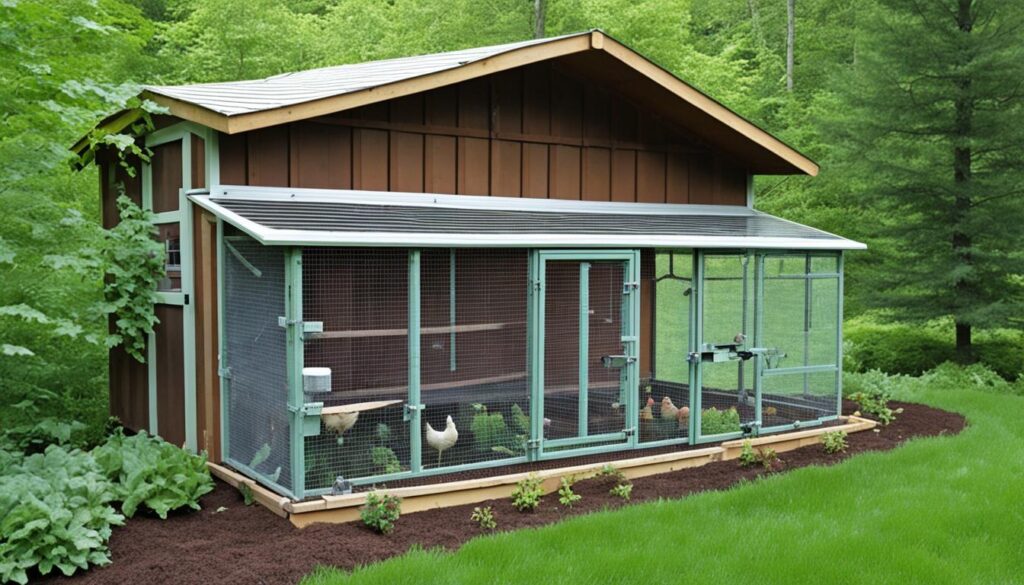
“Deterrents that blend seamlessly with the environment are often the most effective in keeping hawks at bay.”
Conclusion
Protecting backyard birds from hawks needs a mix of strategies. Offer shelter, shield feeders, use deterrents, and add guardian animals. This keeps your birds safe and happy. It’s important to balance keeping predators away with respecting nature.
Hawks are top predators with great hunting skills. They can greatly affect your backyard birds. By understanding nature and using deterrents, you can make a safe space for your birds. This includes using barriers, noise devices, and guardian animals, as explained in this article.
To effectively keep hawks away, use a mix of methods that fit your backyard. Stay alert, adjust your methods as needed, and work with your neighbors. This way, you can enjoy your backyard birds while keeping a balance with nature’s predators.
FAQ
What are some common hawk species found near backyard bird feeders?
Hawks like the Sharp-shinned Hawk, Cooper’s Hawk, Red-tailed Hawk, Merlin, and American Kestrel visit bird feeders. They see these places as a chance to catch smaller birds.
How can I provide shelter for small birds to protect them from hawk attacks?
To keep small birds safe, add natural cover like dense trees and shrubs near feeders. These spots let birds hide from hawks. Also, use native plants that feed the birds, making your yard safe and helpful.
What are some methods to shield feeders from aerial predators like hawks?
Use covered areas for your bird feeders, like under awnings or on lower branches. This makes it hard for hawks to spot the feeders. Covered feeders also hide the birds from above, adding extra protection.
How can I use reflective materials and predator eye balloons to scare away hawks?
Reflective things like shiny tape or balloons can keep hawks away. They confuse and scare the hawks off. Predator balloons and scarecrows look like big predators, keeping hawks away from your area.
How can noise-making devices help scare away hawks?
Devices that make loud noises, like air horns or wind chimes, can scare hawks. These sounds disrupt their hunting and make them avoid your area. Just remember to check local noise laws and think about your neighbors.
How can guardian animals like dogs and roosters help protect against hawk attacks?
Dogs and roosters can keep hawks away from chicken coops. Just their presence can scare off threats. They can also chase away hawks, keeping your birds safe. Donkeys or alpacas can also protect poultry from hawks.
How can I remove attractants from my property to discourage hawks?
Don’t attract hawks by keeping chicken feed and water covered and away from food scraps. Less food and resources means fewer hawks around your yard, keeping your birds safe.
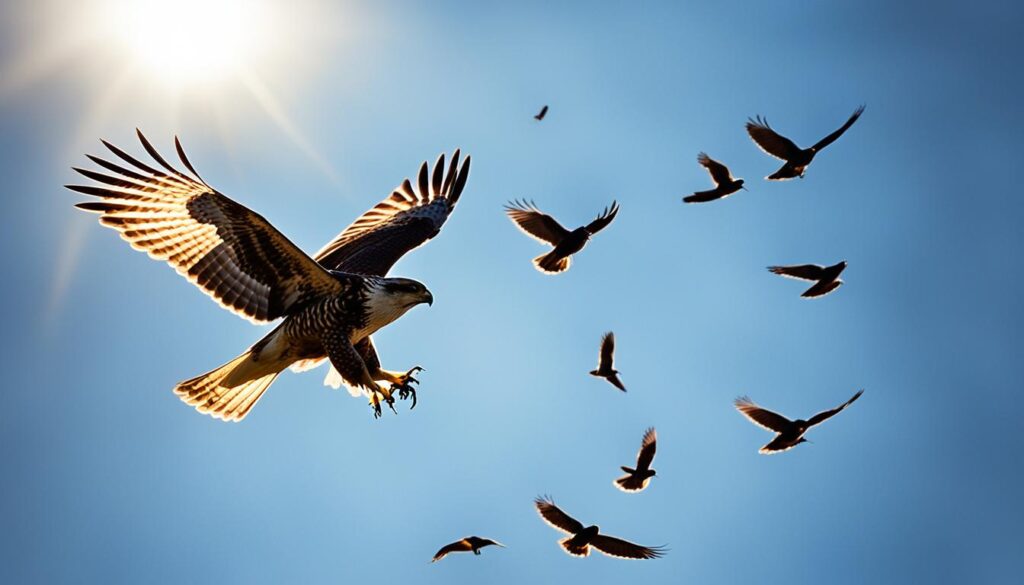

магазин аккаунтов продать аккаунт
продажа аккаунтов магазин аккаунтов
платформа для покупки аккаунтов маркетплейс для реселлеров
маркетплейс аккаунтов продажа аккаунтов соцсетей
магазин аккаунтов https://prodat-akkaunt-online.ru/
магазин аккаунтов https://kupit-akkaunt-top.ru/
магазин аккаунтов маркетплейс аккаунтов
Account Market Account Selling Service
Buy and Sell Accounts Accounts for Sale
Accounts for Sale Account Trading Platform
Account Trading Service Account Purchase
Account exchange Accounts for Sale
Find Accounts for Sale https://socialaccountsstore.com/
Account Buying Platform Account Store
Find Accounts for Sale Ready-Made Accounts for Sale
Website for Selling Accounts Website for Buying Accounts
Sell Pre-made Account Account Buying Platform
Purchase Ready-Made Accounts Buy and Sell Accounts
secure account sales account store
account selling service marketplace for ready-made accounts
accounts marketplace account buying platform
sell accounts sell account
database of accounts for sale secure account sales
purchase ready-made accounts account trading
find accounts for sale https://socialaccountsdeal.com
accounts market account exchange service
marketplace for ready-made accounts guaranteed accounts
account trading service account buying platform
online account store sell account
sell accounts account store
website for selling accounts sell accounts
account sale account marketplace
sell account account acquisition
accounts marketplace find accounts for sale
account trading platform account trading platform
account trading platform buy account
account store account purchase
account trading service account-buy.org
buy accounts find accounts for sale
account selling service accounts market
find accounts for sale online account store
account purchase find accounts for sale
gaming account marketplace account buying platform
verified accounts for sale account trading service
account catalog account market
website for buying accounts sell accounts
account purchase https://accounts-offer.org/
account buying service accounts-marketplace.xyz
sell pre-made account account marketplace
account selling platform https://social-accounts-marketplaces.live/
guaranteed accounts account marketplace
account selling service accounts marketplace
account store accounts marketplace
social media account marketplace https://buy-accounts-shop.pro
buy accounts account marketplace
purchase ready-made accounts https://social-accounts-marketplace.live/
buy accounts https://buy-accounts.live/
account store https://accounts-marketplace.online
account buying platform https://accounts-marketplace-best.pro/
продажа аккаунтов akkaunty-na-prodazhu.pro
площадка для продажи аккаунтов kupit-akkaunt.xyz
биржа аккаунтов https://rynok-akkauntov.top
маркетплейс аккаунтов akkaunt-magazin.online
площадка для продажи аккаунтов https://akkaunty-market.live
покупка аккаунтов маркетплейсов аккаунтов
биржа аккаунтов https://akkaunty-optom.live
биржа аккаунтов маркетплейсов аккаунтов
маркетплейс аккаунтов соцсетей akkaunty-dlya-prodazhi.pro
покупка аккаунтов kupit-akkaunt.online
cheap facebook account buying fb accounts
facebook ad accounts for sale https://buy-ad-account.top
buy facebook accounts for advertising buy a facebook account
buy accounts facebook https://buy-ads-account.click/
buy facebook advertising ad-account-buy.top
buy facebook ad accounts facebook ads accounts
facebook account sale https://ad-account-for-sale.top
cheap facebook account https://buy-ad-account.click
Этот информативный текст отличается привлекательным содержанием и актуальными данными. Мы предлагаем читателям взглянуть на привычные вещи под новым углом, предоставляя интересный и доступный материал. Получите удовольствие от чтения и расширьте кругозор!
Исследовать вопрос подробнее – https://medalkoblog.ru/
buy fb ad account buy facebook ads account
google ads account seller https://buy-ads-account.top
buy facebook accounts cheap buy fb ad account
google ads agency account buy https://buy-ads-accounts.click
google ads account buy ads-account-for-sale.top
google ads agency account buy https://ads-account-buy.work
buy aged google ads accounts google ads reseller
buy account google ads https://buy-account-ads.work
buy verified google ads account buy google ad account
buy google adwords accounts https://sell-ads-account.click
buy adwords account adwords account for sale
buy verified facebook https://buy-business-manager.org/
buy google adwords account https://ads-agency-account-buy.click